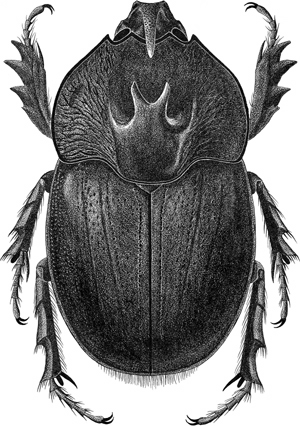 |
|||||||
|
|||||||
........Enema Hope 1837: 83.
........Hoplites Dejean 1836: 167 (nomen oblitum).
Enema pan
|
||
| Dynastinae Taxa Map | ||
| Dynastinae Key | ||
| Oryctini Key |
Distribution: Both are found from southern Mexico to South America with E. pan evidently being more common in South America.
Composition: The genus Enema consists of two species, E. pan (Fabr.) and E. endymion Chevrolat.
Diagnosis: The genus is characterized by quadridentate protibiae, the presence of a frontal horn in both sexes (only rarely is the female lacking a horn), broad elytra that are explanate on the sides, bidentate mandibles, and the near absence of a prosternal process. The presence of a long head horn in both sexes of this genus is distinctive among the New World Dynastinae.
Taxonomic history : The younger of the two names proposed for this genus (Enema Hope, 1837) is the valid name and not the older name (Hoplites Dejean, 1836). See Ratcliffe (2003a) for his action on Reversal of Precedence (Article 23.9.1 of the International Code of Zoological Nomenclature [1999]).
Biological notes: In spite of their large size and occasional local abundance, little is known of the life history of these beetles. Adults are nocturnal and attracted to lights, and the larvae probably feed on humus in the soil. Enema pan may be restricted to forested areas, while E. endymion has been taken both in forested and secondary scrub areas, often in very large numbers.
Literature cited:
Ratcliffe, B. C. 2003a. The dynastine scarab beetles of Costa Rica and Panama (Coleoptera: Scarabaeidae: Dynastinae). Bulletin of the University of Nebraska State Museum 16: 1-506.
|
||||
|
|
